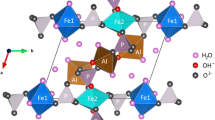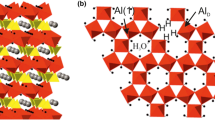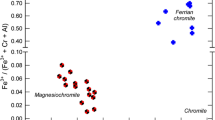Abstract
Polarized absorption spectra of natural piemontite (Ca1.802Mn 2+0.178 Mg0.025) (Mn 3+0.829 Fe 3+0.346 Al1.825) [(Si2.992Al0.008) O12OH], viridine (Al1.945Mn 3+0.033 Fe 3+0.063 Mg0.003) [O|Si0.970 O4], and kanonaite (Al1.291Mn 3+0.682 Fe 3+0.019 ) [O|Si1.006 O4] were measured at 295 and ca. 100 K. For piemontite, lowering the temperature resulted in a sharpening of broad bands in the 10 000–25 000 cm−1 region supporting their assignment to single ion Mn3+ in M3 non-centrosymmetric sites.
Alternatively, in kanonaite, temperature behaviour pointed to a slightly stronger influence of vibronic coupling on strong bands near 16 000 and 22 000 cm−1, which supported an interpretation of Mn3+ in nearly centrosymmetric M1 sites. Measurements at ca. 100 K show pronounced fine structure in the viridine spectra which is attributed to Fe3+. The ɛ values for Mn3+ spin-allowed bands in the three minerals lie in the range 18 to 227 [1·g-atom−1·cm−1].
For the same band and polarisation, ɛ values in Mn3+-bearing andalusite-type minerals viridine and kanonaite are the same, which indicates an absence of strong magnetic coupling effects between Mn3+ ions in the andalusite type structure down to ca. 100 K.
In silicates, the high ɛ values for Mn3+ spin-allowed bands, in comparison to those obtained for Fe2+ spin-allowed bands from sites of “similar distortion”, is attributed to a higher degree of covalency in the Mn3+-O bonds compared to the Fe2+-O bonds, as a result of the higher valence state of manganese.
Similar content being viewed by others
References
Abs-Wurmbach I, Langer K, Tillmanns E (1977) Structure and polarized absorption spectra of Mn3+ substituted andalusites (viridines). Naturwissenschaften 64:527–528
Abs-Wurmbach I, Langer K, Seifert F, Tillmanns E (1981) The crystal chemistry of (Mn3+, Fe3+)-substituted andalusites (viridines and kanonaite), (Al1−x−y Mn 3+ x Fe 3+ y )2(O|SiO4): Crystal structure refinements, Mössbauer, and polarized optical absorption spectra. Z Kristallogr 155:81–113
Annersten H, Hålenius U (1976) Ion distribution in pink muscovite, a discussion. Am Mineral 61:1045–1050
Burns RG (1974) The polarized spectra of iron in silicates: olivine. A discussion of neglected contributions from Fe2+ions in M(1) sites. Am Mineral 59:625–629
Burns RG, Strens RGJ (1967) Structural interpretation of polarized absorption spectra of the Al-Fe-Mn-Cr epidotes. Mineral Mag 36:204–226
Corin F (1934) Spectre d'absorption de la viridine. Bull Soc Geol Belg 44:313–315
Dollase WA (1969) Crystal structure and cation ordering of piemontite. Am Mineral 54:710–717
Dollase WA (1973) Mössbauer spectra and iron distribution in the epidote-group minerals. Z Kristallogr 138:41–63
Faye GH (1968) The optical absorption spectra of certain transition metal ions in muscovite, lepidolite and fuchsite. Can J Earth Sci 5:31–38
Faye GH, Harris DC (1969) On the origin of colour and pleochroism in andalusite from Brazil. Can Mineral 10:47–50
Faye GH, Nickel EH (1969) On the origin of colour and pleochroism of kyanite. Can Mineral 10:35–46
Ferguson J (1975) Introduction to linearly polarized electronic spectra of inorganic crystals. In: Day P (ed) Electronic states of inorganic compounds. Reidel, pp 59–93
Ferguson J, Guggenheim HJ, Wood DL (1964) Electronic absorption spectrum of Ni II in cubic perovskite fluorides. J Chem Phys 40:822–830
Ferguson J, Fielding PE (1972) The origins of the colours of natural yellow, blue, and green sapphires. Aust J Chem 25:1371–1385
Goldman DS, Rossman GR (1977) The identification of Fe2+ in the M(4) site of calcic amphiboles. Am Mineral 62:205–216
Hålenius U (1978) A spectroscopic investigation of manganese andalusite. Can Mineral 16:567–575
Hålenius U (1979) State and location of iron in sillimanite. Neues Jahrb Mineral Monatsh 165–174
Heinrich EW, Corey AF (1959) Manganian andalusite from Kiawa Mountain, Rio Arriba County, New Mexico. Am Mineral 44:1261–1271
Kai AT, Larsson C, Hålenius U (1980) The electronic structure and absorption spectrum of MnO 9−6 octahedra in manganian andalusite. Phys Chem Minerals 6:77–84
Langer K, Abu-Eid RM, Anastasiou P (1976) Absorptionsspektren synthetischer Piemontite in den Bereichen 43 000–11 000 (232.6–909.1 nm) und 4 000–250 cm−1 (2.5–40 μm). Z Kristallogr 144:434–436
Langer K, Frentrup KR (1979) Automated microscope-absorption-spectrophotometry of rock forming minerals in the range 40 000–5 000 cm−1 (250–2 000 nm). J Microsc 116:311–320
Langer K, Smith G, Hålenius U (1982) Reassignment of the absorption spectra of purple yoderite. Phys Chem Minerals 8:143–145
Lever ABP (1968) Inorganic electronic spectroscopy. Elsevier, Amsterdam London New York, pp 131–137, 146–149, 207–217
Manning PG (1968) Absorption spectra of the manganese bearing chain silicates pyroxmangite, rhodonite, bustamite, and serandite. Can Mineral 9:348–357
Manning PG (1970) Racah parameters and their relationship to lengths and covalencies of Mn2+ and Fe3+ oxygen bonds in silicates. Can Mineral 10:677–688
Moore KM, White WB (1972) Electronic spectra of transition metal ions in silicate garnets. Can Mineral 11:791–811
Nelson C, White WB (1980) Transition metal ions in silicate melts. — I. Manganese in sodium silicate melts. Geochim Cosmochim Acta 44:887–893
Runciman WA, Sengupta D, Gourley JT (1974) The polarized spectra of iron in silicates. II. Olivine: A reply, Am Mineral 59:630–631
Smith G, Strens RGJ (1976) Intervalence transfer absorption in some silicate, oxide and phosphate minerals. In: Strens RGJ (ed) The physics and chemistry of minerals and rocks. Wiley and Sons, New York, pp 583–612
Smith G (1977) Low temperature optical studies of metal-metal charge transfer transitions in various minerals. Can Mineral 15:500–507
Smith G (1980) Evidence for optical absorption by Fe2+-Fe3+ interactions in MgO:Fe. Phys Status Solidi A 61:K191–195
Weiss Z, Bailey SW, Rieder M (1981) Refinement of the crystal structure of kanonaite, (Mn3+, Al) [6] (Al, Mn3+) [5] O [SiO4]. Am Mineral 66:561–567
Winter JK, Ghose S (1979) Thermal expansion and high temperature crystal chemistry of the Al2SiO5 polymorphs. Am Mineral 64:573–586
Author information
Authors and Affiliations
Rights and permissions
About this article
Cite this article
Smith, G., Hålenius, U. & Langer, K. Low temperature spectral studies of Mn3+-bearing andalusite and epidote type minerals in the range 30000–5000 cm−1 . Phys Chem Minerals 8, 136–142 (1982). https://doi.org/10.1007/BF00311284
Received:
Issue Date:
DOI: https://doi.org/10.1007/BF00311284




